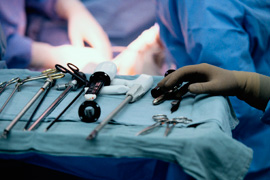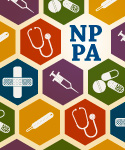December 14th, 2016
Welcome to the Theatre … the Operating Theatre
Megan Tetlow, PA-C

Megan Tetlow, PA-C, is from Fort Myers, Florida, now working in Sheffield, England, as part of the National Physician Associate Expansion Program. She practices in gynecologic oncology and is a guest blogger for In Practice.
The OR here in the U.K. is called the theatre, or operating theatre. If you say OR, you’ll likely get a bemused expression, meaning you’re speaking like an actor from Grey’s Anatomy again. One of my supervising physicians here relayed a story to me from a British mentor of his who had practiced in the U.S. during his training. The doctor had been notified to come to the hospital for an emergency surgery. The OR nurse called him to make sure he was on his way, and he said pleasantly, “Oh no problem, I’m just on my way to the theatre now” — to which the nurse replied in panic, “You’re going to the theater?! We need you in the hospital!” George Bernard Shaw was right: we really are two nations divided by a common language. The differences in this area go beyond semantics and can be quite interesting … and a bit challenging. Today I would like to highlight some of the differences I’ve noticed in working in a British theatre versus an American OR.
Start Time of 8:30 am
Yes, that’s an 8. Theatre lists start a little later here. My attending physicians were particularly aghast when I said that in the U.S., the first case is at 7:30 and we round on everyone on the floor (or ward, if you want to be British) prior to that. We do finish later here, so it all evens out. I didn’t mention that there are no tea breaks in the U.S. either, which would certainly have sounded even more horrifying.
Full Team Brief
This is a practice that was adopted somewhat recently by National Health Service theatres. In NHS hospitals, before the start of the day, the OR team meets for a team brief. The whole team — including the attending surgeon, anesthesiologist (or anaesthetist, again if you want to be properly British), residents, circulating nurses, scrub techs, students, etc. — all meet in a circle. The group then proceeds to introduce themselves and go through a checklist that outlines the cases for the day, reviews any surgical/anesthetic concerns, enumerates any potential patient or safety concerns, and outlines the work flow for the day. I think the full team brief is a great way to make sure everyone on the team is on the same page and also drives home the message that avoiding errors and keeping patients safe is everyone’s responsibility.
Self-Service Dressing
It was my first day working as a PA in the theatre in the U.K. As I walked back to scrub in, one of my attending docs yelled to me, “By the way, it’s self-service here!” I must have looked really confused (quite common during my adjustment to working in the U.K.), because he explained further that here, everyone gowns and gloves themselves (even the most senior attending surgeons). At which point my other doctor exclaimed, “What?! They actually dress you in America? I thought that was just on television!” I’m happy to say that my self-gowning and -gloving time has improved dramatically since my first day.
yelled to me, “By the way, it’s self-service here!” I must have looked really confused (quite common during my adjustment to working in the U.K.), because he explained further that here, everyone gowns and gloves themselves (even the most senior attending surgeons). At which point my other doctor exclaimed, “What?! They actually dress you in America? I thought that was just on television!” I’m happy to say that my self-gowning and -gloving time has improved dramatically since my first day.
Learning the Language
After my first foray into the theatre, it was clear that if I was going to survive there, I would need to learn a whole new set of British surgical lingo. The language differences in the OR here run the gamut from surgical equipment (a  Bovie in the U.S. = handheld diathermy in the U.K.) to surgical techniques (a “flash” in the U.S. — the technique where the assistant slowly releases a clamp just enough that the surgeon can push down the knot on the suture and then regrabs = an “ease-and-squeeze” in the U.K.) to even basic anatomy (the area posterior to the uterus that we would know as the posterior cul-de-sac = the Pouch of Douglas in the U.K. Maybe they don’t have cul-de-sacs in general here? I should find out).
Bovie in the U.S. = handheld diathermy in the U.K.) to surgical techniques (a “flash” in the U.S. — the technique where the assistant slowly releases a clamp just enough that the surgeon can push down the knot on the suture and then regrabs = an “ease-and-squeeze” in the U.K.) to even basic anatomy (the area posterior to the uterus that we would know as the posterior cul-de-sac = the Pouch of Douglas in the U.K. Maybe they don’t have cul-de-sacs in general here? I should find out).
Lacking a British to American English medical and surgical dictionary, the best I can do is learn as much as I can as often as I can — which come to think of it is probably a good motto for any healthcare professional, regardless of your location or geographic vernacular.


Megan, thank you for sharing your experiences. As always I enjoy your humor.
There is “English” – then dialects – American, Canadian, British, Australian, New Zealand, and some times sub dialects.
“Pork the Core” (in Bostonian, for example) = park the car ( in English translation).
An Australian company tried to market a soap to Americans – with “the smell of the great Australian bush (= outback=outdoors=forested nature areas)” – but it didn’t sell so well.
When I first came here (Canada)I though a “side walk” was a gait defect, and a “foot path” was a trail. .. .all very confusing. . . . .
MEGAN TETLOW(PAC),S REPORT WAS ENTERTAINING AND USEFUL.
Megan, as I sit in the OR (theatre) myself, I couldn’t control the giggle that escaped when I read “they actually dress you in America!”. Enjoy reading your posts!
Thank you for the wonderful comments!!